
Imaging: Abell 70, M72, NGC7008, M31, NGC1514
Posted: 15 September 2012
Monsoon clouds snuck in on Thursday, 13 September 2012. Friday dawned clear but breezy. I did a little maintenance on the observatory dome. A seal had dried out in our southern Arizona summer heat and allowed some rain water to drip inside the dome along the edge. I applied some more sealant, which should fix it.
The observatory was opened for observing at 1832 MST, 81°F. The sky was mostly clear but there were clouds low along most of the horizon, with strong breezes at times. Humidity was much less (20%) than on the previous session. I had decided to re-image some of the DSOs I imaged during my previous session, as my guiding that night was not very accurate (due to poor seeing and using very faint guide stars). Redoing these objects would be my main objective for the night. I delayed powering on the 8" LX200-ACF due to the breezes, although I did prepare the D7000 DSLR for prime focus imaging. I finally powered on the telescope at 1920 MST.
At 1932 MST, I mounted the camera at prime focus using the Off-Axis Guider (OAG). The camera was rotated about 90° from its position during the previous imaging session. I hoped this would allow selection of better guide stars. I then did a focus test on the star Altair using the Bahtinov Mask. I slewed to Abell 70 and did two 1 minute, ISO 6400, unguided framing test exposures. I found a good guide star to use for manual guiding corrections with the OAG. At 1958 MST, I captured this cropped, 5 minute, ISO 6400, guided image:
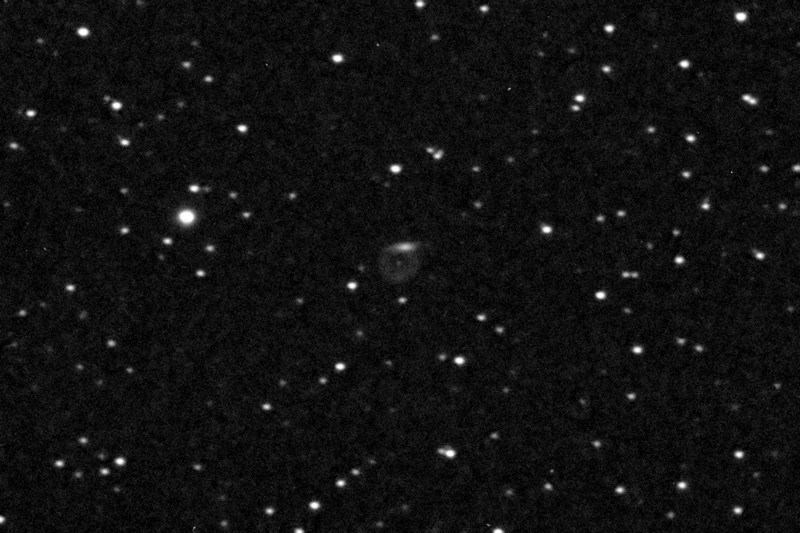
The planetary nebula is visible in the image as a faint (Magnitude +14.5) ring. At the top of the ring is a faint (Mag +16) galaxy (PGC187663).
My next re-do imaging target was the globular cluster M72. My first image was out-of-focus; apparently the focus slipped even though the telescope focus was locked. I re-did the focus with Altair and the Bahtinov Mask. Then slewed back to M72. This is a 30 second, ISO 6400, unguided, cropped image:
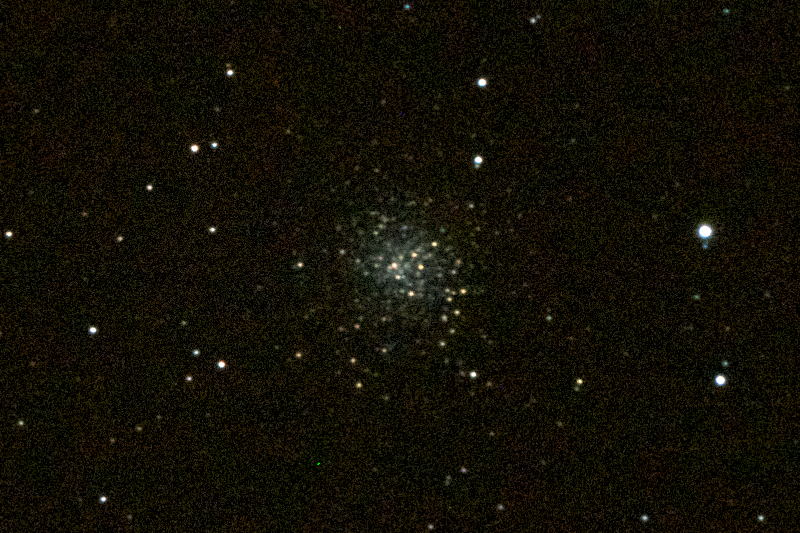
At 2032 MST, I did a framing test exposure of the planetary nebula NGC7008 (another re-do). I found an excellent guide star and did 2, 3, and 5 minute, ISO 6400, guided exposures. During post-processing I stacked these three images using Lynkeos, yielding this image with an effective exposure length of 10 minutes:
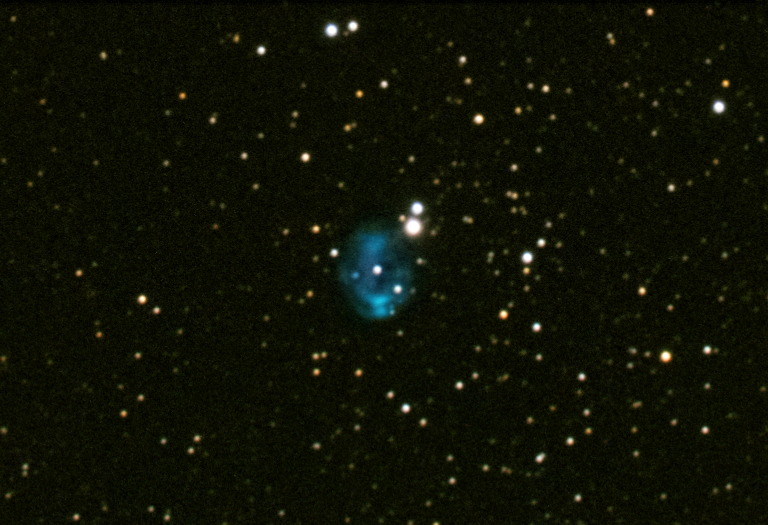
I removed the camera from the 8" prime focus and set up for piggyback imaging of M31, the Great Andromeda Galaxy. The lens was set for f/5.6 at 300mm. At 2143 MST, I did a focus test image of M31, and then did a 10 minute, ISO 5000, guided exposure. Unfortunately, the image was way overexposed. I then did a 5 minute, ISO 5000, exposure, but that image was trailed. I repeated the image but that one was also trailed. Apparently, my head was bumping the camera while my eye was at the guiding reticle eyepiece. I decided to try a series of unguided, 2 minute, ISO 5000, exposures. This worked much better. I took 10 exposures, each 2 minutes, ISO 6400. I ended imaging at 2241 MST. During post-processing I stacked the 10 images using Lynkeos, for an effective exposure length of 20 minutes. This is the result:
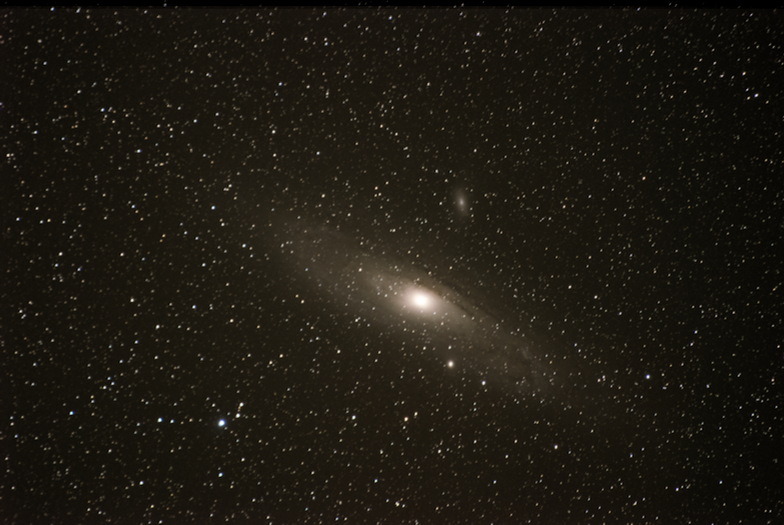
For comparison, here is a single, unedited, 2 minute, exposure:
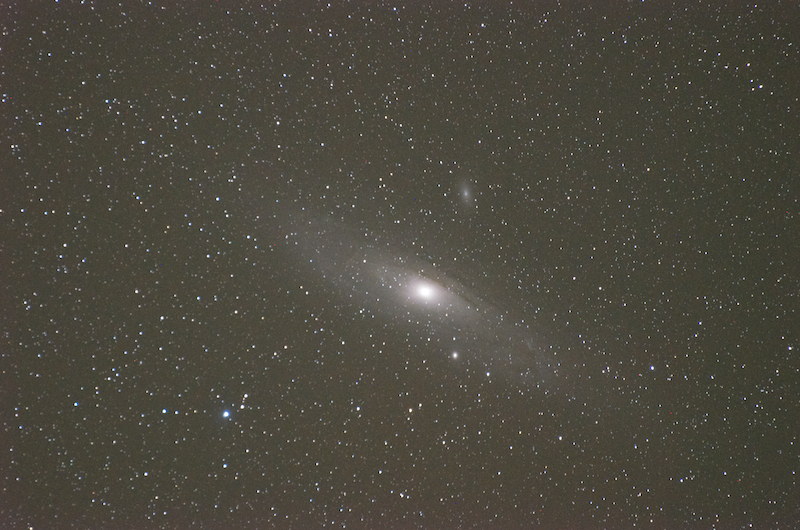
While I was imaging M31, the neighbor to the northwest kept turning on a very bright nuisance light. It was lighting up the surrounding area well beyond his property line. About 3 years ago I had spoken to him about his light and even offered to pay to have it shielded. He declined my offer but said he would shield it. Obviously, he hasn't. The light kept coming on this night. I finally figured out that the wind was activating a motion sensor. I took this photo of the nuisance light at 2259 MST through some tree branches near the observatory:
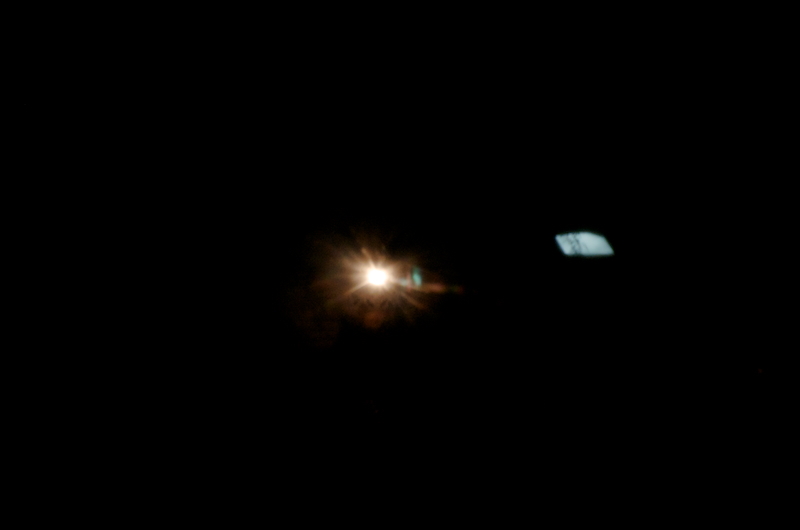
The pale blue rectangular light on the right is a roof skylight on his house, illuminated by interior house lighting.
At 2314 MST, while waiting for my next (re-do) imaging target to rise higher in the eastern sky, I viewed M45, the Pleiades, low in the east, at 77X. At 2322 MST, I viewed the imaging target, the faint planetary nebula NGC1514, low in the east, 77X. The nebula was visible using averted vision. Strong breezes were a concern, as they had been all night. The forecast said the wind would calm down after sunset. The forecast was wrong. At 2325 MST, I closed the observatory dome due to the wind. I then began D7000 DSLR preparations for prime focus imaging. As earlier this night, the camera was mounted using the OAG rotated about 90° from its position two nights ago.
The dome was re-opened at 2355 MST. Strong breezes were still blowing. Did a focus test on Algol with the Bahtinov Mask. Then did two framing test exposures on NGC1514 and found a guide star. I then did a 5 minute, ISO 6400, guided exposure. This is the cropped result:
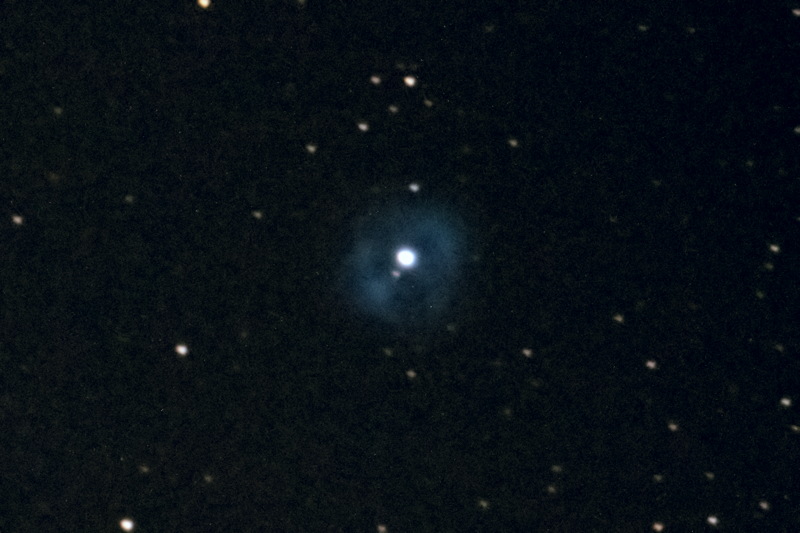
Finished imaging at 0021 MST. At 0030 MST, viewed Jupiter and the four Galilean Moons, low in the east, 77X. I then slewed the telescope to the asteroids Vesta and Ceres, low in the eastern sky. I made no attempt to actually ID the asteroids in the eyepiece field-of-view as my purpose this night was to just determine where they were in relation to my horizon. A future session will involve viewing and imaging of these two asteroids.
Strong breezes were continuing, so I decided to close up for the night. Even with the wind, this was an effective 6 hour 16 minute session. The observatory was closed at 0048 MST, 64°F.
Comments are welcome; use the Comments section below, or you can Email Me. Thanks.
Go to the previous report.
Return to the Cassiopeia Observatory Welcome Page.